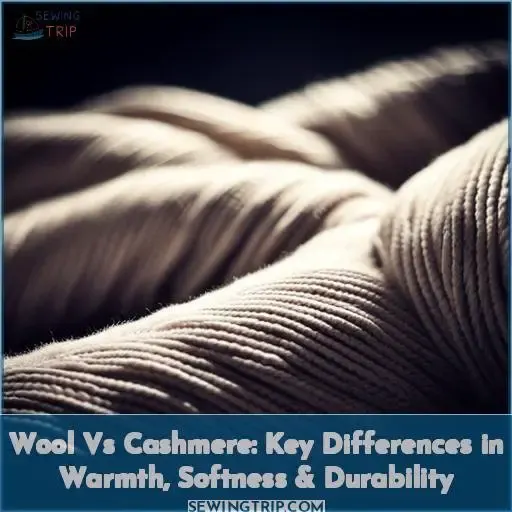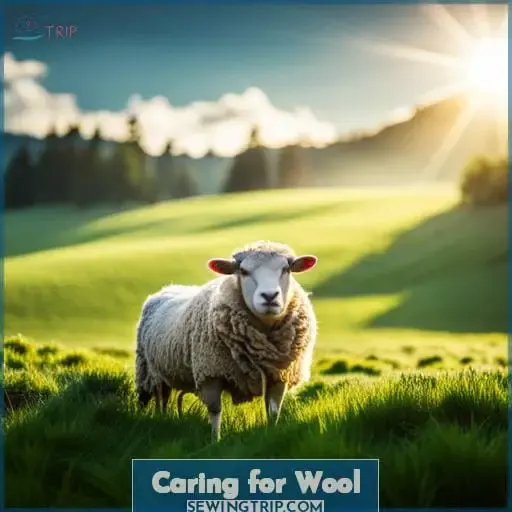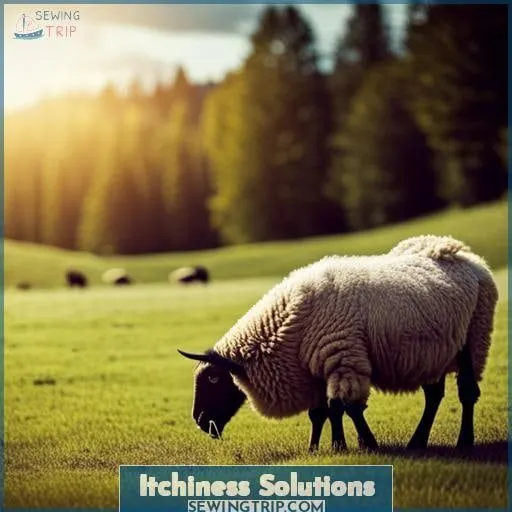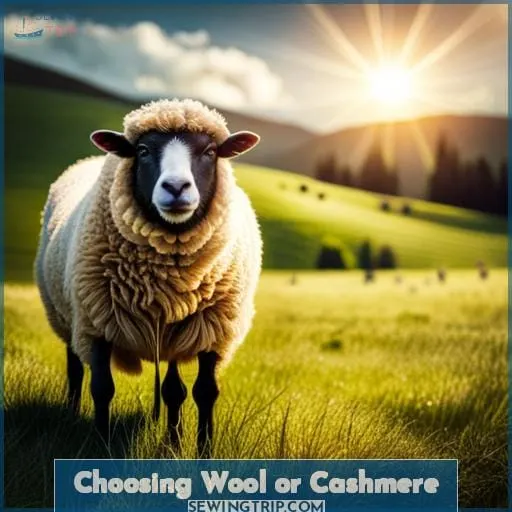This site is supported by our readers. We may earn a commission, at no cost to you, if you purchase through links.
 You’re shopping for a winter sweater and wondering about the differences between wool and cashmere.
You’re shopping for a winter sweater and wondering about the differences between wool and cashmere.
Wool comes from sheep and is known for its durability. Cashmere is shorn from goats and praised for its exceptional softness. While both fibers naturally insulate, cashmere is lighter yet warmer. It’s also more delicate and expensive.
Ultimately, choosing between wool and cashmere depends on your budget and needs. Seek wool when longevity is key; choose cashmere for unbeatable softness and warmth. With some care, either natural fiber will serve you well when the winter winds blow.
Table Of Contents
Key Takeaways
- Wool comes from various animal sources like sheep, goats, alpacas, and rabbits, while cashmere comes exclusively from cashmere goats.
- Wool is more durable due to its thicker, sturdier fibers, while cashmere is delicate.
- Wool excels in cold and wet climates, while cashmere is ideal for moderately cold and dry conditions.
- Cashmere is significantly more expensive than wool due to its limited supply and labor-intensive production.
What is Wool?
Wool wraps you in its sturdy, enduring embrace like a trusted old friend. Originating from various animals like sheep, goats, alpacas, and rabbits, wool envelops you in effective insulation and breathable comfort.
From the common sheep’s wool to the exceptionally warm and rare qiviut, wool comes in many types with unique properties. Though requiring delicate care like hand-washing, wool’s versatility allows it to be spun into countless garments, blankets, and accessories that provide cozy warmth for generations.
With wool’s diverse sources and manufacturing processes compared to the scarcer cashmere goat hair, each fiber offers singular advantages. But wool’s abundance and strength persistently enfold us, evoking the reassuring warmth of belonging.
What is Cashmere?
With cashmere, you’re cocooning yourself in pure luxury. Cashmere originates from the soft, insulating undercoat that cashmere goats naturally grow as protection from the elements. This extraordinarily fine natural fiber is gently combed and collected by hand during the goats’ spring moulting season.
Compared to sheep’s wool, cashmere delivers superior warmth and softness – it’s prized for its luxury appeal.
Yet it also readily blends with wool for added durability; common cashmere blends have a 70/30 or 80/20 ratio.
Its unparalleled softness envelops you in a subtle, sophisticated elegance unlike any other natural fiber. So for both exceptional comfort and timeless luxury, cashmere’s sublime sensuality is in a class of its own.
Key Differences
You’re going to discover how much finer and softer cashmere feels against your skin.
Cashmere and wool differ in key ways:
- Fiber diameter – Cashmere fibers are finer at 15-18 microns vs. wool at 25-35 microns.
- Softness – Cashmere’s delicate fibers make it far softer.
- Warmth – The finer the fiber, the better the heat retention, giving cashmere superior insulating properties.
- Source – Cashmere comes from cashmere goats, while wool has various animal sources such as sheep.
Cashmere offers unrivaled softness and warmth despite its delicate nature. When blended with wool, it brings out the best in both fibers – softness from the cashmere and durability from quality wools. Ultimately, with proper care, cashmere endures as a luxurious and versatile fiber.
Which is Warmer?
You’d be cozier bundled up in cashmere this winter. Cashmere’s unparalleled insulation comes from its ultra-fine diameter, allowing more trapped air per length of fiber.
Sourced from cashmere goats’ soft undercoat during spring moulting, cashmere provides lightweight warmth three times that of wool. Though merino and other wools wick moisture, cashmere’s breathability and warmth-to-weight ratio are king for frigid temps.
Blending cashmere with heartier wools combines insulation with durability, but 100% cashmere excels for enveloping cold weather gear. So while wool has its place in layered clothing, pure cashmere is the pinnacle for natural fiber properties that’ll keep you cozy when temperatures plummet.
The cashmere comb’s precious yield creates the most insulating, softest natural fabric.
Which is More Durable?
Wearing wool, you’ve got durability in the bag. With its thick, sturdy fibers and natural oils, most wool types can handle repeated wear and washing without showing much wear. Merino wool boasts impressive longevity too. Cashmere’s ultrafine hairs make for sublime softness, yet render it less hardwearing over time.
Blending cashmere with heartier wool creates a balance – amping up durability so your knits hold up longer. With proper care, luxurious cashmere can still offer enduring value as it gracefully ages.
Overall, wool’s inherent strength makes it the clear winner for hardiness. Though with some TLC, cashmere’s delicate beauty lasts. So choose the fiber fitting your lifestyle and lean into nature’s gifts of comfort and longevity.
Caring for Wool
When hand-washing your woolens, be sure to use a gentle detergent and lay flat to air dry. To care for wool, start by checking the manufacturer’s instructions as some wools should be dry cleaned. When washing at home, use a mild detergent made for delicates in cool to lukewarm water.
Avoid hot water or harsh detergents which may cause shrinking or felting. Gently squeeze suds through the garment rather than agitating and roll in a towel to remove excess moisture before laying flat on a mesh rack to dry.
To store wool, keep in breathable garment bags and use cedar blocks or lavender sachets to deter moths.
With proper care, your woolens can provide seasons of warmth. Though delicate, wool rewards those who invest a little extra attention into its laundering and storage.
Caring for Cashmere
A 50/50 wool cashmere blend sweater needs extra special care, as cashmere fibers are delicate and require handwashing instead of machine washing to avoid pilling.
- Hand wash or dry clean only using a gentle detergent, never machine wash
- Fold garments flat or hang on wide, padded hangers to prevent stretching
- Store in breathable cotton garment bags and avoid plastic that traps moisture
- Use a cashmere comb to gently remove any pills that develop over time
With proper maintenance, an investment cashmere piece can last for many years while retaining its luxurious softness and insulation. Taking the time to gently hand wash and store cashmere properly helps extend the lifespan of this indulgent fabric.
Itchiness Solutions
Ditch the prickly sweater and go for a softer wool blend to stop the scratching. Certain types, like merino and cashmere, tend to be less itchy against sensitive skin. Blending with softer wools, like lambswool or even cotton, silk, or cashmere, can reduce irritation.
Conditioning garments with a wool-safe product helps soften fibers over time, too. For severe allergies, layering a thin cotton or silk base layer under wool can create a barrier. Choosing loosely knit or woven styles and sizing up minimizes direct contact as well.
With some trial and error finding the right wool type, gauge, and blend ratio, you can stay cozy in winter garments without irritation. Wool-safe conditioners and strategic layering provide soothing solutions for itchiness.
Choosing Wool or Cashmere
When deciding between wool or cashmere, begin by considering the tradeoff between warmth and durability. Cashmere’s finer fibers more efficiently trap heat, yet wool tends to be more resilient against wear-and-tear over time.
Also compare softness and potential skin irritation, since cashmere’s smoothness avoids the itchiness that some wool types may cause. Finally, keep in mind that due to scarcity, cashmere comes at a significantly higher cost of production.
Warmth Versus Durability
Sophisticated insight touches you when prioritizing cozy warmth or hardy endurance.
The breathable thickness of wool and cashmere differs, so compare their properties when picking seasonal suits. Cashmere’s refined softness excels at trapping heat for frigid days. Though wool stays sturdy through active wear, cashmere’s weakness requires extra care.
Try blending wool’s strength with cashmere’s warmth for balanced winter wardrobes. Mastering the right textile techniques preserves their quality. The breathable thickness of wool and cashmere differs, so compare their properties when picking seasonal suits.
Cashmere’s refined softness excels at trapping heat for frigid days. Though wool stays sturdy through active wear, cashmere’s weakness requires extra care.
– Softness and Itchiness
Run your fingers over the cashmere’s silky fibers and revel in its cozy softness as it caresses your skin without an ounce of itch. Unlike the prickly texture of some wool garments, cashmere offers unrivaled comfort with its delicate, downy-soft fibers that gently wrap you in a soothing embrace.
Though wool types like Merino provide exceptional softness too, cashmere’s supreme caress against the skin gives it the advantage for those wanting to avoid any hint of abrasion. For sensitive skin prone to wool allergies, cashmere’s purity grants the ultimate experience of featherlight luxury.
– Production Cost Differences
You’re shelling out more for cashmere. Cashmere production is incredibly labor-intensive, as each goat produces just a few ounces yearly. In contrast, machines harvest wool from abundant sheep herds quite efficiently. With global demand rising, the limited cashmere supply drives prices skyward.
Savvy buyers weigh the extra cost against the unparalleled softness and warmth of cashmere.
Frequently Asked Questions (FAQs)
Wool excels in very cold and wet climates thanks to its natural water repellency. Cashmere provides lightweight insulation ideal for moderately cold and dry conditions. The finest cashmere can even be worn year-round.
You can rely on wool when facing wet, cold weather. However, cashmere’s fine fibers insulate against moderate cold without the bulk.
Conclusion
You’ve covered the key differences between wool and cashmere – from warmth and softness, to production cost and care. Now you can weigh the priorities – whether it’s durable wool or luxurious cashmere – and choose the right fabric for your lifestyle and climate.
Trust your own instincts, feel the materials, and you’ll discover which natural fiber truly suits your sense of comfort and style.















